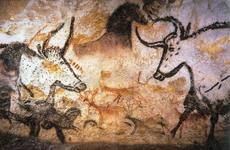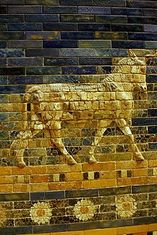 Aurochs in the caves of Lascaux, France, ca. 17,000 BCE.
Aurochs in the caves of Lascaux, France, ca. 17,000 BCE. . The auroch is one of those animals that seems to straddle the gap between myth and reality. During their neolithic heyday when great herds of these mighty bovine wandered throughout western Europe, aurochs were among the first animals to have their portraits painted. Images of aurochs can be found in the caves of Lascaux dating back to around 17,000 BCE. We know they are aurochs because of the long, curved, almost curly horns that distinguish themselves from their cousins the bulls and bisons.
A few millennia later aurochs found a place of honor on the Gates of Ishtar, welcoming visitors to the great city of Babylon. The row of flowers underneath their hooves may remind one of Ferdinand, the gentle flower-loving bull of the eponymous childhood classic. However, it was the aurochs' very un-Ferndinand like qualities that may of brought them down. In fact, if you were going to write a picture book about aurochs, you might entitle it, "The Ornery Auroch," While most other Indo-European bovines were busy being domesticated, the auroch remained a wild hold out, fierce, territorial, and ready to gore anyone or anything that challenged it.
Some seemed to have been interbred with cattle to produce stronger, hardier breeds, but as humans took control of the landscape authentic aurochs begin to loose their habitat. Their numbers dwindled during the middle ages and by the Renaissance few remained. The last, lonely auroch gave up the ghost in a Polish forest in 1627. Since then the only place you were likely to encounter an auroch is in fantasy. George Martin, for instance, has made good use of them in the Game of Thrones and aurochs (actually pot-bellied pigs in digital disguise) featured prominently in the 2012 indie film Beasts of the Southern Wild. Until now. Enter the aptly names Taur0s Project (yes, thats Tauros with an 'o' as the Greeks wrote it). Starting in 2008 a group of dedicated scientists began to bring the auroch back.
A few millennia later aurochs found a place of honor on the Gates of Ishtar, welcoming visitors to the great city of Babylon. The row of flowers underneath their hooves may remind one of Ferdinand, the gentle flower-loving bull of the eponymous childhood classic. However, it was the aurochs' very un-Ferndinand like qualities that may of brought them down. In fact, if you were going to write a picture book about aurochs, you might entitle it, "The Ornery Auroch," While most other Indo-European bovines were busy being domesticated, the auroch remained a wild hold out, fierce, territorial, and ready to gore anyone or anything that challenged it.
Some seemed to have been interbred with cattle to produce stronger, hardier breeds, but as humans took control of the landscape authentic aurochs begin to loose their habitat. Their numbers dwindled during the middle ages and by the Renaissance few remained. The last, lonely auroch gave up the ghost in a Polish forest in 1627. Since then the only place you were likely to encounter an auroch is in fantasy. George Martin, for instance, has made good use of them in the Game of Thrones and aurochs (actually pot-bellied pigs in digital disguise) featured prominently in the 2012 indie film Beasts of the Southern Wild. Until now. Enter the aptly names Taur0s Project (yes, thats Tauros with an 'o' as the Greeks wrote it). Starting in 2008 a group of dedicated scientists began to bring the auroch back.
 Auroch on the Ishtar Gate of ancient Babylon, ca. 575 BCE.
Auroch on the Ishtar Gate of ancient Babylon, ca. 575 BCE. How are they doing that? Mostly by identifying the auroch DNA in so-called antique or heritage breeds of European cattle and 'back-breeding' them to enhance their auroch-like qualities. This method of reviving a lost species was done somewhat successfully for the American bison back in the 20th century. Will it succeed for the auroch? So far, the project has produced some pretty feisty specimens as well as a lot of enthusiastic press. Will one of these "neo 'rochs" someday stop and smell the flowers? We'll just have to wait and see.